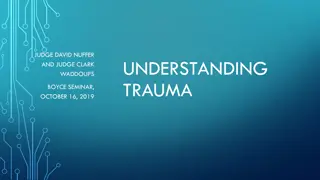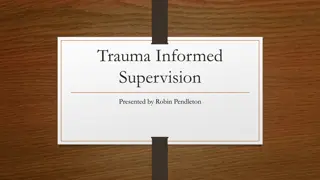Exploring Trauma and Memory in Beloved: Preliminary Pages, Main Characters, and Context
The opening of the novel "Beloved" by Toni Morrison portrays trauma and haunting memories, examining the significance of preliminary notes and dedications. The introduction of main characters like Sethe, Denver, Paul D, and Baby Suggs delves into their internal lives and symbolic representations. The context of Margaret Garner, the inspiration behind the story, sheds light on the intense mother-child relationships under slavery and the struggles faced by refugees from bondage.
Uploaded on Sep 14, 2024 | 0 Views
Download Presentation

Please find below an Image/Link to download the presentation.
The content on the website is provided AS IS for your information and personal use only. It may not be sold, licensed, or shared on other websites without obtaining consent from the author. Download presentation by click this link. If you encounter any issues during the download, it is possible that the publisher has removed the file from their server.
E N D
Presentation Transcript
BELOVED LO: How does the opening of the novel portray trauma and haunting memories?
PRELIMINARY PAGES What is the significance of this preliminary What is the significance of this preliminary note? note? What is the significance of this dedication? What is the significance of this dedication? Sixty Million and More I will call them my people, Which were not my people; And her beloved, Which was not beloved (Romans 9:25)
PRELIMINARY PAGES: THE BIBLE PASSAGE IN MORE DETAIL This introduces the issue of calling and identity It also cites a New Testament passage, which repeats with little difference an Old testament passage This suggests that there is some uncertainty as to the relation between the past and the present, or as to what version of a truth is right I will call them my people, Which were not my people; And her beloved, Which was not beloved (Romans 9:25)
HOW ARE THE MAIN CHARACTERS INTRODUCED? Sethe Denver Paul D The ghost Baby Suggs In your groups, collect quotes introducing these characters (focus on the first section, up to p. 23) Think about: Think about: How do their actions show their internal their actions show their internal lives lives (emotions, hidden memories, etc) Is there any important symbolic object or metaphoric image or metaphoric image used to introduced this character? How would you interpret it? (for example: the metal imagery for Sethe, Denver s broken jar for jam and biscuits, Baby Sugg s colours, Paul D s trembling ) symbolic object
CHARACTERS IN CONTEXT: MARGARET GARNER Beloved is based on the true story of an ex-slave named Margaret Garner, who attempted to kill her children to prevent them from returning to slavery. Taking this event as the germ for her story, Morrison weaves it into a story about refugees from slavery, caught between remembering and forgetting what they have been through. The novels also explores the intensity of a mother s relationship with children, particularly under slavery. Image: Anti-slavery bugle. (New-Lisbon, Ohio), 02 Feb. 1856. Chronicling America: Historic American Newspapers. Lib. of Congress. https://chroniclingamerica.loc.gov/lccn/sn83035487/1856- 02-02/ed-1/seq-3/
CHARACTERS IN CONTEXT: MARGARET GARNER Read up on Margaret Garner in Samuel May s antislavery tract The Fugitive Slave Law and Its Victims https://www.gutenberg.org/files/13990/13990-h/13990-h.htm ( (The Fugitive Slave Acts The Fugitive Slave Acts were federal laws that allowed for the capture federal laws that allowed for the capture and return of runaway enslaved people and return of runaway enslaved people within the territory of the United States. Enacted by Congress in 1793, it authorized local governments to seize and return escapees to their owners and imposed penalties on anyone who aided in their flight. Widespread resistance to the 1793 law led to the passage of the Fugitive Slave Act of 1850, which added more provisions regarding runaways and levied even harsher punishments for interfering in their capture. The Fugitive Slave Acts were among the most controversial laws of the early 19th century.) Quote from the tract: And the young wife and mother, into whose very soul the iron had entered, hearing the cry of the master: "Now we'll have you all!" turning from the side of her husband and father, with whom she had stood to repel the foe, seized a knife, and with a single blow nearly severed the head from the body of her darling daughter Image: Thomas Satterwhite Noble, Magaret Garner, Public Domain.
Writing Trauma: How to read Toni Morrison s style Read up to p. 23 Beloved is characterised by a style that is elliptical, references are made to events or characters that are only explained later on: coherence is denied memories (of Sweet Home, seethe s escape, etc) start here and there, so that the present is shot through with the past but they aren t developed chronologically Also, language is open to ambivalence, multiple meanings, and contradictory connotations language is open to ambivalence, multiple meanings, and contradictory connotations: Symbolism of the chamomile Description of Sethe s baking vs the atrocities she is talking about Imagery of milk Select examples of such a style: in what ways is this Gothic? How does this create a sense of Select examples of such a style: in what ways is this Gothic? How does this create a sense of haunting? How does this haunting compare and contrast to other Gothic texts you have read? haunting? How does this haunting compare and contrast to other Gothic texts you have read? elliptical, and time-scales that are quite elastic: elastic:
How would you describe Morrisons style in these quotations? "The welcoming tool of unchiseled headstone; the one she selected to lean against on tiptoe, her knees wide open as any grave. Pink as a fingernail it was, and sprinkled with glittering chips." "Suddenly there was Sweet Home rolling, rolling, rolling out before her eyes [ ] in shameless beauty. [ ] Boys hanging from the most beautiful sycamore trees in the world." "Paul D tied his shoes together, hung them over his shoulder and followed her through the door straight into a pool of red and undulating light that locked him where he stood" "her eyes did not pick up a flicker of light. They were like two wells into which he had trouble gazing [ ] Then schoolteacher arrived to put things in order. But what he did broke three more Sweet Home men and punched the glittering iron out of Sethe's eyes, leaving two open wells that did not reflect firelight." "The five Sweet Home men looked at the new girl and decided to let her be. They were young and so sick with the absence of women they had taken to calves. Yet they let the iron-eyed girl be, so she could choose" "I can't live here. Nobody speaks to us. Nobody comes by. Boys don't like me. Girls don t either." "Schoolteacher made one open my back and when it closed it made a tree. It grows there still. [ ]He rubbed his cheek on her back and learned that way her sorrow, the roots of it. Its wide trunk and intricate branches."
KEY CONCEPT: TRAUMA What is trauma? Here are some quotations about trauma in literature: Identify the key words in each quote what can you infer about trauma? Which are most helpful in explaining how Toni Morison presents memories? Laura Di Prete: Trauma is a "foreign body" in the mind trauma can be best understood through plural, multi-disciplinary perspectives (Luckhurst 2008) Coupland and Coupland (1997: 117) have called trauma a discourse of the unsayable . "Perhaps the most striking feature of traumatic recollection is the fact that it is not a simple memory." (Cathy Caruth, 1995) "The attempt to gain access to a traumatic history, then, is also the project of listening beyond the pathology of individual suffering, to the reality of a history that in its crises can only be perceived in unassimilable forms" (Cathy Caruth, 1995) In trauma, "the body keeps the score" (Bessel van der Kolk) Van der Kolk (2014: 21) stresses the enduring changes brought about by the experience of trauma: "We have learned that trauma is not just an event that took place sometime in the past; it is also the imprint left by that experience on mind, brain, and body. This imprint has ongoing consequences for how the human organism manages to survive in the present. Trauma results in a fundamental reorganization of the way mind and brain manage perceptions. It changes not only how we think and what we think about, but also our very capacity to think. Sigmund Freud, 1920: (People] think the fact that the traumatic experience is forcing itself upon the patient is a proof of the strength of the experience: the patient is, as one might say, fixated to his. trauma. I am not aware, however, that patients suffering from traumatic neurosis are much occupied in their waking lives with memories of their accident. Perhaps they are more concerned with not thinking of it. (Freud, 1920, 13)
How does Toni Morrison introduce memories How does Toni Morrison introduce memories of a violent history in the opening of her of a violent history in the opening of her novel? novel? Based on what we have just discussed, write a Based on what we have just discussed, write a paragraph to evaluate this. paragraph to evaluate this. How does Toni Morrison introduce memories of a violent history in the opening of her novel? Use the following concepts: Use the following concepts: Trauma Elliptical style Ambivalence / multiple meanings / contradictions
TONI MORRISON AND HISTORY: THE BLACK BOOK The Black Book grew out of certain concerns Morrison had about race and language, one being Morrison s sense that the Black is beautiful idea of the time reduced the complexity of Black American life to a slogan. She was equally dissatisfied with academic treatises that did not get at the heart and spirit behind the culture. Morrison worked with collectors of Black memorabilia and a graphic designer to put The Black Book together. She wanted the largely visual work to be a kind of scrapbook, or panorama, of Black American life, largely free of language and thus cant, and valuable to the young. I was afraid that young people would come to believe that black history began in 1964, she told an interviewer. Or that there was slavery, there was a gap, and then there was 1964.























